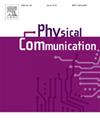STARS 辅助 NOMA 环境反向散射通信
IF 2
4区 计算机科学
Q3 ENGINEERING, ELECTRICAL & ELECTRONIC
引用次数: 0
摘要
同时发射和反射面(STARS)是实现全空间覆盖的一项革命性技术。本文研究了 STARS 在基于非正交多址的环境反向散射通信(NOMA-AmBC)网络中的应用,在 STARS 的帮助下,反向散射信号被分别反射和传输给用户 n 和用户 f。具体来说,我们推导出了反向散射信号和一对用户的中断概率和遍历率的新的精确和近似表达式。根据渐近分析结果,我们给出了 STARS-NOMA-AmBC 网络的分集阶数和复用增益。为了便于比较,我们进一步推导出了 STARS 辅助正交多址 AmBC(STARS-OMA-AmBC)网络的中断概率和遍历率的精确表达式。数值结果证实了我们的分析,并表明(i) STARS-NOMA-AmBC 的中断行为优于 STARS-OMA-AmBC;(ii) 随着可重构元素和反向散射系数数量的增加,反向散射信号有能力获得更大的性能增益;以及 (iii) STARS-NOMA-AmBC 网络的遍历性能优于可重构智能表面辅助 AmBC 网络。本文章由计算机程序翻译,如有差异,请以英文原文为准。
STARS aided NOMA ambient backscatter communications
Simultaneously transmitting and reflecting surface (STARS) has emerged as a revolutionary technology to enable full spatial coverage. This paper investigates the application of STARS into non-orthogonal multiple access based ambient backscatter communication (NOMA-AmBC) networks, where the backscatter signals are separately reflected and transmitted to user n and user f with the help of STARS. Specifically, we derive new exact and approximate expressions of outage probability and ergodic rate for backscatter signals and a pair of users. Based on the asymptotic analytical results, the diversity order and multiplexing gain are provided for STARS-NOMA-AmBC networks. For the purpose of comparison, we further deduce the exact expressions of outage probability and ergodic rate for STARS aided orthogonal multiple access AmBC (STARS-OMA-AmBC) networks. The numerical results confirm our analysis and show that: (i) The outage behaviors of STARS-NOMA-AmBC are superior to that of STARS-OMA-AmBC; (ii) As the number of reconfigurable elements and backscatter coefficients increases, the backscatter signal has ability to acquire the greater performance gains; and (iii) The ergodic performance of STARS-NOMA-AmBC networks is better than that of reconfigurable intelligent surface assisted AmBC networks.
求助全文
通过发布文献求助,成功后即可免费获取论文全文。
去求助
来源期刊

Physical Communication
ENGINEERING, ELECTRICAL & ELECTRONICTELECO-TELECOMMUNICATIONS
CiteScore
5.00
自引率
9.10%
发文量
212
审稿时长
55 days
期刊介绍:
PHYCOM: Physical Communication is an international and archival journal providing complete coverage of all topics of interest to those involved in all aspects of physical layer communications. Theoretical research contributions presenting new techniques, concepts or analyses, applied contributions reporting on experiences and experiments, and tutorials are published.
Topics of interest include but are not limited to:
Physical layer issues of Wireless Local Area Networks, WiMAX, Wireless Mesh Networks, Sensor and Ad Hoc Networks, PCS Systems; Radio access protocols and algorithms for the physical layer; Spread Spectrum Communications; Channel Modeling; Detection and Estimation; Modulation and Coding; Multiplexing and Carrier Techniques; Broadband Wireless Communications; Wireless Personal Communications; Multi-user Detection; Signal Separation and Interference rejection: Multimedia Communications over Wireless; DSP Applications to Wireless Systems; Experimental and Prototype Results; Multiple Access Techniques; Space-time Processing; Synchronization Techniques; Error Control Techniques; Cryptography; Software Radios; Tracking; Resource Allocation and Inference Management; Multi-rate and Multi-carrier Communications; Cross layer Design and Optimization; Propagation and Channel Characterization; OFDM Systems; MIMO Systems; Ultra-Wideband Communications; Cognitive Radio System Architectures; Platforms and Hardware Implementations for the Support of Cognitive, Radio Systems; Cognitive Radio Resource Management and Dynamic Spectrum Sharing.
 求助内容:
求助内容: 应助结果提醒方式:
应助结果提醒方式:


